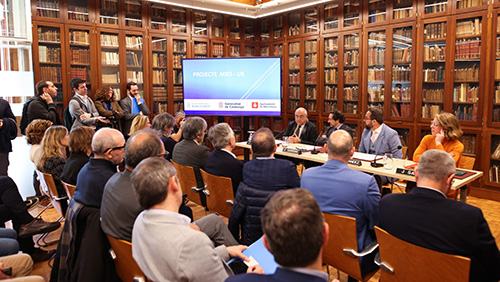The UB science and research infrastructures gain momentum


The two buildings to be yet built will be located in two different areas:
-
The Faculty of Mathematics and Computer Sciences will be built between the streets Joan Obiols and John M. Kenyes. The Faculty will leave the Historical Building and will be moved to the Diagonal Campus. This building will also be used by several research groups on economics from the Faculty of Economics and Business.
-
On the island of the South Campus —the current headquarters of the New Interactive Technologies School (ENTI)—, between the streets Llorenç Artigas, Pascual i Vila, Baldiri i Reixac and Adolf Florensa, a 10,000 m2 building will be built, and it will expand the Barcelona Science Park (PCB). Moreover, it will be the headquarters of the Institute of Bioengineering of Catalonia (IBEC) and several UB health research groups.
The Catalan Government will be in charge of the construction of both buildings through the Institut Català del Sòl (INCASOL), depending on the Department of Territory, with a 50-million-euro investment. The UB or the entities that settle in the buildings will then pay for rent to INCASOL, which will equal the expenses. These rental incomes will be compensated with the granting of the funding from the European Regional Development Fund (ERDF), linked to the research infrastructures that will be placed in these buildings.
The rector of the UB, Joan Guàrdia, regarded this day as a historic one, regarding the spaces and infrastructures of the University. “In fifteen years, Barcelona will have become a higher attraction pole for talent and knowledge of first-world magnitude. We are placing one more piece so this becomes real, and we are doing so thanks to the collaboration between administrations”, he said.
The Catalan minister for Territory, Juli Fernàndez, explained: “Through a surface right in favour of INCASOL, we will make this tangible”. He added that, although the Department of Territory is usually seen as the “brick and cement”, its work consists on improving the life of citizens. “This is what gives meaning to what we do”. In this sense, he stressed that “a better space gives us the chance to have a better education and research system, and more capacities”.
The Catalan minister for Research and Universities, Joaquim Nadal, highlighted the importance of this project, “which, added to other operations in the field of knowledge, such as the one of the new Clínic, will draw a scientific arch that will strengthen the Catalan research and university system”. In this sense, he remembered there will be many research centers and other universities involved, with which they will collaborate. “We have to do it well together; it’s not only about the continent but about the content too”.
Finally, the deputy mayor for Ecology, Urbanism, Infrastructure and Mobility, Janet Sanz, claimed the city’s commitment in working on this project. “We are proud of this public university, and this is why all the administrations have to make the future of the university possible, because the city’s future and the country depend on it. We want Barcelona to be consolidated as the undoubtable capital of science and research in southern Europe. In urbanism, we will do everything we can so that these buildings become a reality”, she said.
Committed to science
The commitment to this project confirms the UB’s commitment to excellence and talent recruitment in strategic fiends such as mathematics, computer science, health sciences and economics.
The MIES-UB strategic project aims to, on the one hand, give a response to the high demand the PCB receives by expanding the facilities with a new building, which will be fully dedicated to the research activities in the field of health. Also, this new building will shelter the IBEC headquarters and several research groups of the University. On the other hand, the project aims to strengthen the fields linked to mathematics, computer science and economics by building another building that will be the home to the Faculty of Mathematics and Computer Science, and which will have spaces for the research activities linked to these disciplines.
The reorganization of the spaces in the south area of Diagonal Campus will strengthen the role of the UB, focusing on new nodes of expertise (MIES) that will contribute to making this campus a powerful international reference in southern Europe. At the same time, the building of the new building of Health Sciences will strengthen the main Health area of the University, with the future relation with the new Hospital Clínic, to be placed in the current facilities of UB Sports.
The Barcelona City Council is committed to facilitating the procedures of different urban planning instruments that will make the construction of the buildings possible, in particular, the parcelling of the properties, the necessary planning and the granting of the corresponding licenses.
Multimedia gallery

MIES protocol signature
The Catalan Government will be in charge of the construction of both buildings through the Institut Català del Sòl (INCASOL), depending on the Department of Territory, with a 50-million-euro investment.
Flickr
MIES protocol signature
The rector of the University of Barcelona, Joan Guàrdia; the Catalan minister for Research and Universities, Joaquim Nadal, and the second deputy mayor of the Barcelona City Council, Janet Sanz, signed today the MIES protocol, with which the UB launches a strategic project to promote research and talent in the field of mathematics, computer science, economics and health (MIES-UB).

